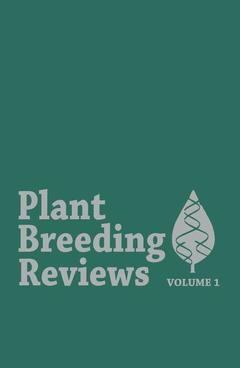Description
Plant Breeding Reviews, Softcover reprint of the original 1st ed. 1983
Volume 1
Author: Janick J.
Language: English
Subjects for Plant Breeding Reviews:
Keywords
Publication date: 04-2012
398 p. · 15.5x23.5 cm · Paperback
398 p. · 15.5x23.5 cm · Paperback
Description
/li>Contents
/li>
Plant breeding, the domestication and systematic improvement of crop species, is the basis of past and present agriculture. Our so called primitive progenitors selected practically all our present-day crop plants, and the improvement wrought through millenia of selection has so changed some of them that in many cases their links to the past have been obliterated. There is no doubt that this ranks among the greatest of human achievements. Although plant breeding has been a continuous empirical activity for as long as humans have forsaken the vagaries and thrill of hunting for the security and toil of agriculture, genetic crop improvement is now very much of a twentieth-century discipline. Its scientific underpinnings date to the beginning of this century with the discovery of Gregor Mendel's classic 1865 paper on the inheritance of seven characters in the garden pea. If any science can be traced to single event, the best example is surely found in the conception of modern genetics that appears in this single creative work. The relationship of plant breeding progress to advances in genetics has become closely entwined. Mendel himself was concerned with crop improvement and worked on schemes for apple and pear breeding. Plant breeding also has claims on other scientific and agricultural disci plines-botany, plant pathology, biochemistry, statistics, taxonomy, entomology, and cytology, to name a few-and has also impinged on our social, ethical, economic, and political consciousness.
1 Dedication: Henry A. Jones (1889–1981) Plant Breeder Extraordinaire.- Text.- Publications of H.A. Jones.- 2 The Genetics of Petunia.- I. Introduction.- II. Chromosomes.- III. Chromosome Numbers.- IV. Genes.- V. Chromosome Mapping.- VI. Mutagenesis and Mutability.- VII. Somatic Cell Investigations.- VIII. Conclusion.- 3 Breeding Common Bean for Improved Quantity and Quality of Seed Protein.- I. Introduction.- II. Composition of Seed Protein.- III. Variation in Seed Protein Expression.- IV. Utilization of Genetic Variation for Improvement Through Breeding.- V. Use of Molecular Genetic Engineering.- VI. The Impact of Improved Seed Protein Quantity and Quality.- 4 Genetics of Storage Protein in Maize.- I. Introduction.- II. Definition.- III. Chemistry.- IV. Genetic Regulation.- V. Relationship with Grain Quality and Productivity.- VI. Concluding Remarks.- 5 The Use of Endosperm Genes for Sweet Corn Improvement.- I. Introduction.- II. Historical Perspective.- III. Variability of Endosperm Genes.- IV. Biochemical Considerations.- V. Current Cultivars in Production.- VI. Problems and Perspectives.- 6 Breeding Pearl Millet.- I. Introduction.- II. Reproduction.- III. Cytogenetics.- IV. Germplasm.- V. Breeding.- 7 Breeding Soybeans Resistant to Diseases.- I. Introduction.- II. Breeding Methods.- III. Fungal Diseases.- IV. Bacterial Diseases.- V. Virus Diseases.- VI. Nematodes.- VII. Summary and Conclusions.- 8 The Genetic Improvement of Black Walnut for Timber Production.- I. Introduction and Historical Perspective.- II. Floral Structure and Reproduction.- III. Germplasm Sources and Preservation.- IV. Variation and Inheritance.- V. Breeding Strategies.- VI. Seed Orchards.- VII. Production and Distribution of Improved Stock.- VIII. Future Directions.- 9 The Genes of Lettuceand Closely Related Species.- I. Gene Nomenclature.- II. Gene Descriptions.- III. Gene Linkage.- 10 Breeding Apple Rootstocks.- I. Introduction.- II. Breeding Programs.- III. A Sequential Approach to Apple Rootstock Breeding.- IV. Screening Protocols.- V. Breeding for Specific Orchard Attributes.- VI. Nursery Characteristics.- VII. Tolerance of Factors of Physical Environment.- VIII. Resistances to Diseases and Animal Pests.- IX. Seed Propagated Rootstocks.- X. Novel Methods of Improving Genotypes.- XI. Conclusion.
© 2024 LAVOISIER S.A.S.
These books may interest you

Dictionary of Plant Breeding 61.25 €

Dictionary of Plant Breeding 208.65 €

Horticultural Plant Breeding 122.46 €

